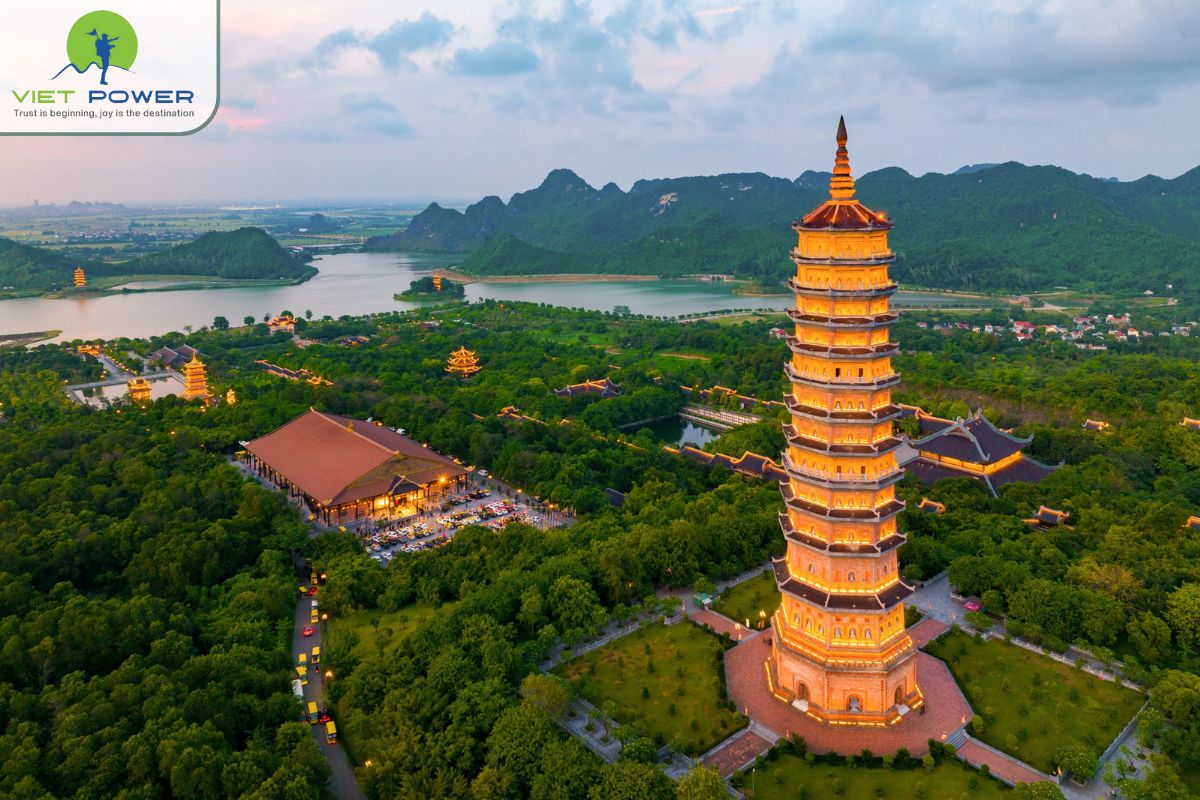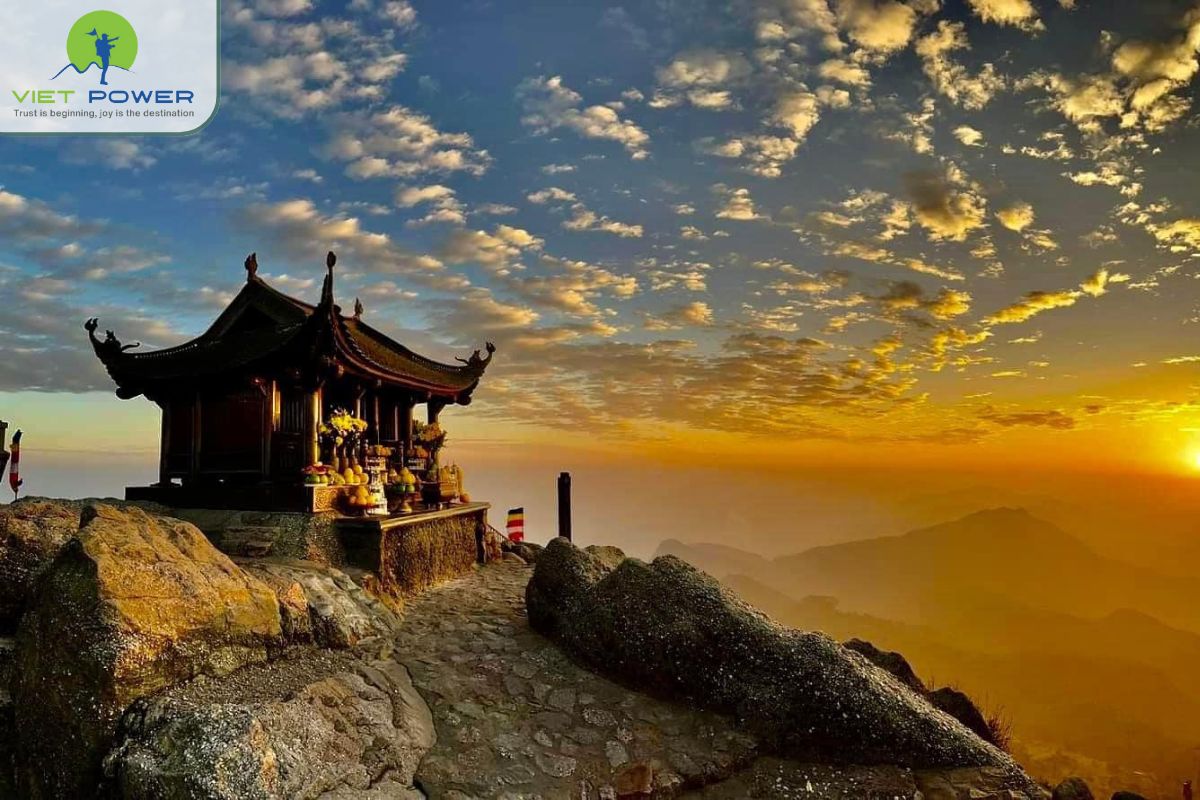Buddhism has been part of Vietnamese culture for more than 2,000 years. People consider the North as the birthplace of Vietnamese Buddhism, where many ancient pagodas have stood for centuries. Visiting these places is not only a spiritual experience but also a journey into the country’s deep history and culture. Let Vietpower Travel introduce you to four of the most famous pagodas in Northern Vietnam that you shouldn’t miss.
Tran Quoc Pagoda, located on a small island in West Lake, Hanoi, is known as the oldest pagoda in the capital and one of the most sacred in Northern Vietnam. Over time, the pagoda has been praised in poems and inscriptions by kings and scholars, especially during the Nguyen Dynasty, showing its importance in Vietnamese literature and royal culture.
Built in the 6th century under the Ly Nam De Dynasty, it was originally situated by the Red River before being relocated to its current site in 1616 due to erosion. Over the centuries, the pagoda has changed its name several times, each reflecting a different wish of the Vietnamese people. We can list from founding and stabilizing the country to protecting it. Its current name, “Tran Quoc” means “Defending the Nation”.

Architecturally, Tran Quoc Pagoda is a harmonious combination of traditional Buddhist style and Vietnamese cultural aesthetics. The pagoda complex includes three main houses forming the Vietnamese “I-shaped” layout: the Front House, Ancestor House, and Stele House.
Each structure carries symbolic meaning, the number three in Vietnamese belief represents luck and prosperity. Visitors often notice that the main gate appears slightly tilted, a unique feature that gives the pagoda its special charm. Entering the pagoda on the paved path of red brick, the 3 main houses appear. At the center is the Front House, and on 2 sides are Ancestor House and Stele House.
The Front House is where people practice religion, with an incense burner in the yard where people pray for good things in life. The Front House faces the west with the bell tower in the front, which brings about a wide view, sacred and peaceful feeling. The Ancestor House is where people worship the former monks of pagoda. There are 14 steles which are preserved in the Stele House, which keeps the long history of one of the oldest Pagodas in the North of Vietnam.
.jpg)
One of the most remarkable highlights here is the sacred Bodhi Tree, a gift from Indian President Rajendra Prasad in 1959. It is said to be grown from a branch of the original Bodhi tree under which Buddha attained enlightenment. This makes Tran Quoc Pagoda not only a place of worship but also a symbol of the spiritual connection between Vietnam and India.
Tip for visiting Tran Quoc Pagoda – The Oldest Pagoda in Hanoi
Tran Quoc Pagoda is busiest on the 1st and 15th days of the lunar month when local people come to pray. If you prefer a quiet experience, visit in the early morning when the sunlight reflects beautifully on West Lake, creating a truly peaceful atmosphere.
About 60 kilometers southwest of Hanoi, Huong Pagoda, is one of Vietnam’s largest and most famous religious complexes in the Northern Vietnam.
Surrounded by majestic limestone mountains and gentle rivers, this sacred site offers visitors a serene journey through both nature and spirituality. The name “Huong,” meaning “fragrance,” comes from the scent of wildflowers and herbs that bloom across the valley each spring. Locals believe that this fragrance carries the blessings of the mountain goddess, filling the entire area with peace and holiness.

According to legend, the site was discovered more than 2,000 years ago by a Buddhist monk who meditated nearby. The first temple was built in the 15th century, marking the beginning of a pilgrimage tradition that continues today.
The pagoda complex stretches over a wide area of mountains, caves, and rivers, with each location holding deep spiritual meaning. The main sites include Thien Tru Pagoda (Heaven Kitchen), known for its elegant design and gardens; Huong Tich Cave, the central pilgrimage site often called “Vietnam’s First Cave”. We can not miss Giai Oan Pagoda, a place to pray for forgiveness; and Tien Son Cave, which fascinates visitors with its glittering stalactites.
Every spring, from the 1st to the 3rd lunar month, the Perfume Pagoda Festival takes place, attracting thousands of pilgrims from across the country. People travel by boat along the peaceful Yen Stream, light incense, offer prayers, and enjoy folk games and local performances. It’s one of Vietnam’s most spiritual and colorful festivals.
.jpg)
Travel tips to Huong Pagoda: Start early in the morning to avoid crowds and enjoy the calm scenery. Wear comfortable walking shoes, and consider hiring a local guide who can share the stories and legends hidden behind each temple and cave.
When mentioning famous pagodas in the Northern Vietnam, we can not miss Bai Dinh Pagoda. Located in Ninh Binh Province, Bai Dinh Pagoda is the largest Buddhist complex in Vietnam and a symbol of modern Vietnamese Buddhism.
The original pagoda was built in the 11th century under King Ly Thai To but was later damaged by time. In 2003, the new pagoda complex was expanded and reconstructed on a grand scale, combining the sacred atmosphere of the old pagoda with impressive modern architecture.

The Bai Dinh Pagoda complex covers hundreds of hectares, blending ancient caves and temples with monumental structures. The old pagoda area lies on the hillside, built mainly from wood and stone, with intricate carvings that reflect ancient Vietnamese craftsmanship. In contrast, the new pagoda features vast courtyards, towering pillars, and colossal bronze statues, harmonizing traditional design with modern elements.
Bai Dinh holds several remarkable records: the largest bronze Buddha statue in Southeast Asia, the largest collection of Arhat statues (500 in total), the largest bronze bell in Vietnam, and the greatest number of Bodhi trees in the country.
Walking through the 13-kilometer-long Corridor of Arhat Statues, visitors can admire hundreds of stone figures, each with a unique facial expression symbolizing a different spiritual state. The Kuan-Yin Hall houses a massive 80-ton statue of the Bodhisattva with a thousand eyes and arms. While the Main Hall of Dharma is dedicated to the Buddha and his teachings, offering a space of calm and reflection.
.jpg)
Tip for visitors: The pagoda complex is huge, so electric cars are available for easier transportation. You can also explore the ancient caves nearby or climb to the top of the hill for breathtaking views of Ninh Binh’s limestone mountains and peaceful countryside.
Yen Tu Pagoda is one of the most sacred pagodas in the North of Vietnam. Situated in Quang Ninh Province, it is considered the cradle of Vietnamese Zen Buddhism and one of the most sacred pilgrimage destinations in the country.
The site is not only a complex of temples but also a historical and natural treasure. Over 700 years ago, after leading Vietnam to victory against the Mongol invasions, King Tran Nhan Tong gave up his throne to live a life of meditation on Yen Tu Mountain. There, he founded the Truc Lam Zen sect, creating a uniquely Vietnamese school of Buddhism. Because of his devotion, people called him the “Buddhist King.”

The Yen Tu pagoda complex follows classical Buddhist architecture, with brick courtyards, wooden halls, and a traditional three-entrance gate symbolizing liberation. Among all, Dong Pagoda (Bronze Pagoda) is the most sacred spot, recognized as the largest and highest bronze pagoda in Vietnam. Standing on the top of the mountain, it is believed to be a place where heaven and earth meet, bringing harmony and spiritual enlightenment to all who visit.
Beyond its spiritual value, Yen Tu is also famous for its breathtaking scenery. The mountains are covered with green bamboo forests, often half-hidden in floating clouds. Walking through the forest path feels like stepping into a poetic painting, where nature and faith blend perfectly together.
How to visit Yen Tu Pagoda? Visitors can choose between taking a modern cable car that offers a bird’s-eye view of the forest or walking the traditional 6-kilometer stone path with more than 6,000 steps. The trek may be long, but the peaceful atmosphere and spectacular views make it truly rewarding.
.jpg)
Discover more posts on the same topic and dive deeper into Vietnam’s beauty, culture, and landmarks. Explore our Vietnam tourist attractions category to find new destinations worth adding to your travel list.
We've visited some of the famous Pagodas in the North of Vietnam, from the ancient beauty of Tran Quoc, the spiritual majesty of Huong Pagoda, the grand architecture of Bai Dinh, to the sacred calm of Yen Tu. Each destination tells a different story about the soul of Vietnamese Buddhism. Together, they form the spiritual heart of Northern Vietnam, where history, devotion, and peace come together. If you are planning a trip to Vietnam and want to explore its spiritual heritage, make sure these four pagodas are on your list. Vietpower Travel accompany with you in exploring the beauty of Vietnam, so book your tour now!